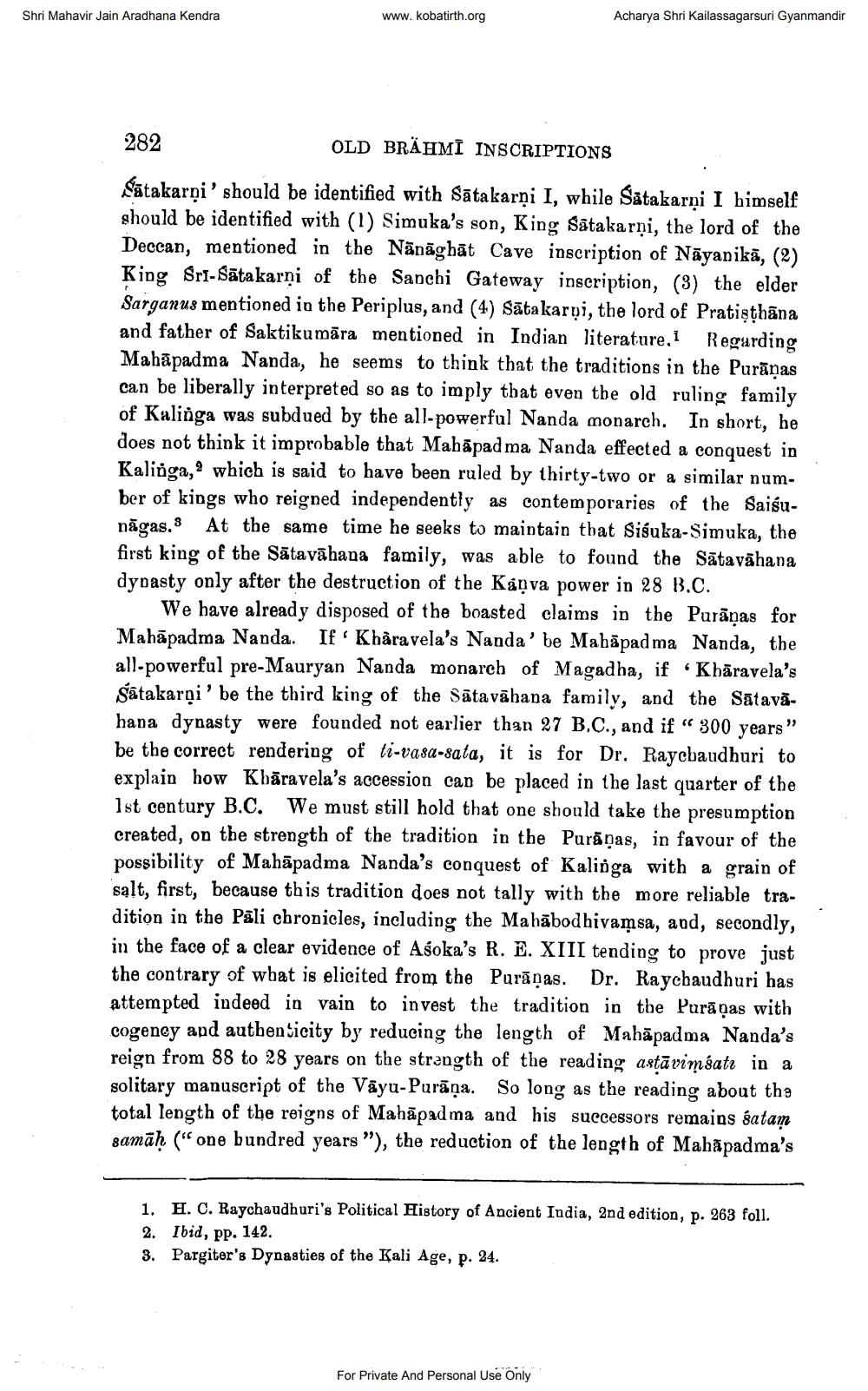________________
Shri Mahavir Jain Aradhana Kendra
www. kobatirth.org
Acharya Shri Kailassagarsuri Gyanmandir
282
OLD BRÄHMI INSCRIPTIONS Satakarņi' should be identified with Sātakarņi I, while Satakarņi I himself should be identified with (1) Simuka's son, King Satakarni, the lord of the Deccan, mentioned in the Nānāghāt Cave inscription of Nāyanikā, (2) King Sri-Satakarņi of the Sanchi Gateway inscription, (3) the elder Sarganus mentioned in the Periplus, and (4) Sāta karvi, the lord of Pratisthāna and father of Saktikumāra mentioned in Indian literature,i Regarding Mahāpadma Nanda, he seems to think that the traditions in the Purānas can be liberally interpreted so as to imply that even the old ruling family of Kalinga was subdued by the all-powerful Nanda monarch. In short, he does not think it improbable that Mahāpadma Nanda effected a conquest in Kalinga,” which is said to have been ruled by thirty-two or a similar number of kings who reigned independently as contemporaries of the Saišunāgas. At the same time he seeks to maintain that Sisuka-Simuka, the first king of the Sātavāhana family, was able to found the Sātavāhana dypasty only after the destruction of the Kaņva power in 28 B.C.
We have already disposed of the boasted claims in the Puranas for Mahāpadma Nanda. If Khåravela's Nanda' be Mahāpadma Nanda, the all-powerful pre-Mauryan Nanda monarch of Magadha, if 'Khāravela's Satakaroi' be the third king of the Sāta vāhana family, and the Satavāhana dynasty were founded not earlier than 27 B.C., and if “ 300 years" be the correct rendering of ti-vasa-sata, it is for Dr. Raycbaudhuri to explain how Kbāra vela's accession can be placed in the last quarter of the 1st century B.C. We must still hold that one should take the presumption created, on the strength of the tradition in the Purānas, in favour of the possibility of Mahāpadma Nanda's conquest of Kalinga with a grain of salt, first, because this tradition does not tally with the more reliable tradition in the Pāli chronicles, including the Mahābodhivamsa, and, secondly, in the face of a clear evidence of Asoka's R. E. XIII tending to prove just the contrary of what is elicited from the Parāṇas. Dr. Raychaudhuri bas attempted indeed in vain to invest the tradition in the Purāṇas with cogency and authenticity by reducing the length of Mahāpadma Nanda's reign from 88 to 28 years on the strength of the reading astāvimšati in a solitary manuscript of the Vāyu-Purāņa. So long as the reading about the total length of the reigns of Mahāpadma and his successors remains satam samāḥ ("one bundred years "), the reduction of the length of Mahāpadma's
1. H. C. Raychaudhuri's Political History of Ancient India, 2nd edition, p. 263 foll. 2. Ibid, pp. 142. 3. Pargiter's Dynasties of the Kali Age, p. 24.
For Private And Personal Use Only




